Regulation of the cell cycle involves not only detection and repair of genetic damage but also prevention of uncontrolled cell division. The molecular events that control the cell cycle occur in a sequential fashion. It is impossible to reverse the cell cycle as it is unidirectional.
Mitotic cell cycle is the result of a sequence of biochemical and structural events that occur during interphase. The most important of these is the duplication of the genome in S phase and mitotic division in M phase. S phase and M phase must occur in the correct order and only once per cell cycle. For this reason S phase and M phase do not follow immediately after one another but are separated by “gaps” that allow the cell to check that everything is in order before going on to the next stage.
The gap between M phase and S phase is called G1 and the gap between S phase and M phase is called G2. These four phases, G1, S, G2, and M make up the classic cell cycle. Non-dividing cells are said to be in the G0 phase. G0 cells can remain viable for months or even years. Most of the cells in the human body are in this state. Cells are said to be terminally differentiated, if they are unable to return to cell division cycle (Ex: Nerve cells). In contrast other differentiated cells, such as glial cells, can return to the cycle if they receive the correct signals.
Telomeres: Mammalian cells typically divide only about 50 times. This limit is set by the presence of repeated sequences of DNA at telomeres. In young cells, the sequence TTAGGG is repeated hundreds or thousands of times but each time the cell divides, it loses 50 to 200 of these repeats. Cells that have divided many times have fewer of these repeats left.
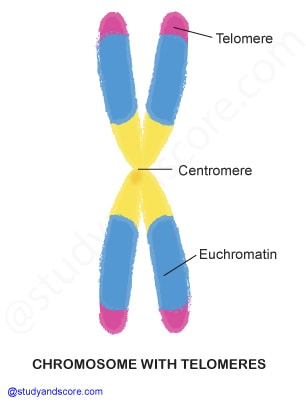
When the telomere is reduced to a certain size, the cell can no longer divide. Telomeres are restored to their original length by an enzyme called telomerase. This enzyme contains a single strand of RNA that is used to synthesize the telomeres. Telomerase is usually found in cells involved in the production of gametes. It is not normally found in somatic cells.
Cyclin-Dependent Kinases: Activated proteins are need for the cell cycle to proceed from G1 to S and from G2 to mitosis. Kinases activate these proteins by transferring a phosphate group from ATP and thus stimulate the cell cycle to continue. Kinases themselves are normally inactive and must be activated before they can activate other proteins. Cyclin-dependent kinases become activated by combining with cyclin.
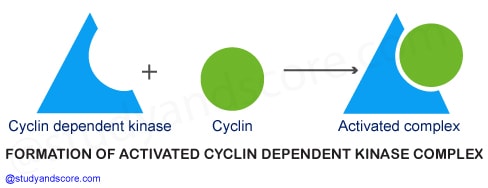
The level of cyclin fluctuates depending on the requirement; at low levels, kinases are not activated so the cell cycle is halted and at high levels, activation occurs and the cycle resumes.
Growth Factors: By promoting the binding of cyclin to kinase, growth factors stimulate nearby cells to divide. Generally, cyclin combines with kinase only when growth factors are present. For example, damaged tissue releases growth factors thereby stimulating cell division to repair the damaged tissue.
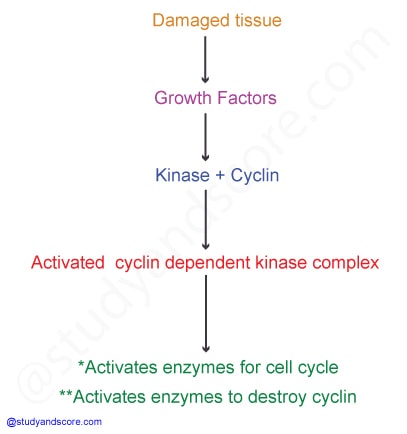
S-Kinase combines with S-cyclin & the resulting active complex stimulates DNA replication and the cell cycle crosses through the check point at G2 phase. The active S-kinase cyclin complex also activates enzymes that destroy the S-cyclin if the checkpoint criteria are not met.
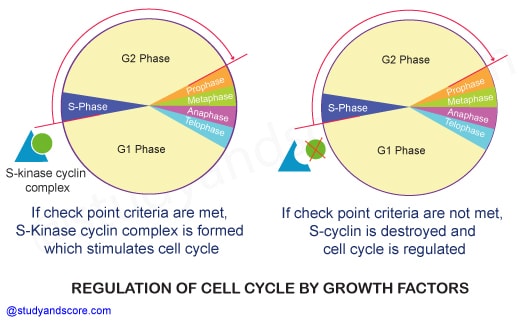
M-Kinase combines with M-cyclin & this active M-kinase cyclin complex initiates mitotic events like chromosome condensation, nuclear membrane disintegration & synthesis of spindle apparatus. The active M-kinase cyclin complex also activates enzymes that destroy M-cyclin.
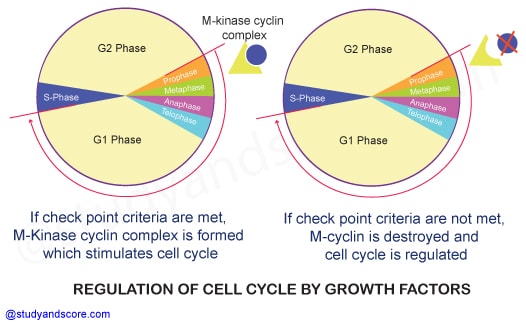
Cell cycle check points: The cell uses the cell cycle checkpoints to monitor and regulate the progress of the cell cycle. Checkpoints prevent the progress of the cell cycle at specific points there by allowing repair of DNA damage. The cell cannot proceed to the next phase until checkpoint requirements have been met.
Several checkpoints are designed to ensure that damaged or incomplete DNA is not passed on to daughter cells. Three main checkpoints exist namely, G1/S checkpoint, G2/M checkpoint and Exit M phase transition. P53 plays an important role in triggering the control mechanisms at all the checkpoints.
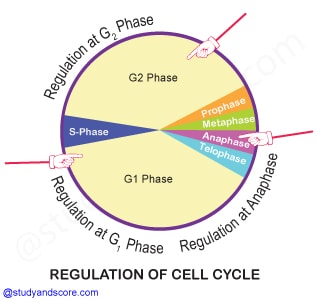
When the environment is not favorable, P53 protein stops the cell cycle causing the cell to die. When the proteins that regulate the cell cycle are mutated or absent, cells can divide uncontrollably, leading to cancer.
Some cells stop at G2 phase and some stop at G1 phase. Moreover Anaphase will not begin until all of the chromosomes are attached to the spindle apparatus.
- Share with your friends! -
Login to post your comment here...
- or with social Account -